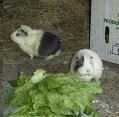 |
Bungala Ridge Permaculture Gardens REDUCE ... REUSE ... RECYCLE ... REPAIR ... RETURN ... REVEGETATE ... REPLENISH |
||||||||
|
|||||||||
|
|
Permaculture Techniques - Useful Animals in a Permaculture System Bees We have decided to include a bee hive in our permaculture system. The bees will ensure good pollination on the property and provide honey for our consumption, preserving, and beeswax for polishes, candles, etc. We chose to use a commercial bee hive with removable frames for ease of use and compatibility if we decided to obtain more hives. Bee hives needs to be weather proof and placed in a cool sheltered position away from low lying boggy areas. Because of this we have placed the hive in centrally in zone 5, our native plant regeneration area. This provides access to flowering plants for the bees all year round, with access to the house garden, vegetable garden and orchard, plus neighbouring properties. It was important to site the hive in an area that isn't frequented often to avoid the risk of accidental bee sting. Our many shallow frog ponds provide year round drinking water. Maintenance of the Hive
When working the hive we always wear adequate protective clothing, light in colour and close fitting at openings. This includes a veil to protect the face and gloves. A smoker is a necessary tool to make the bees docile. A bee brush to gently remove bees from the comb and a hive tool for separating frames are also useful. Harvest: Treatment: Use: Links Layla sent in this link of a list of herbs that bees like which she is growing in her garden. She also found these infographics full of tips. Also,the infographic at the very bottom is a list of native plants, which is a better choice for gardens. back to Animals
|
Hot Links!
This site is sponsored by
|
|||||||
|
|
|
|
|||||||




